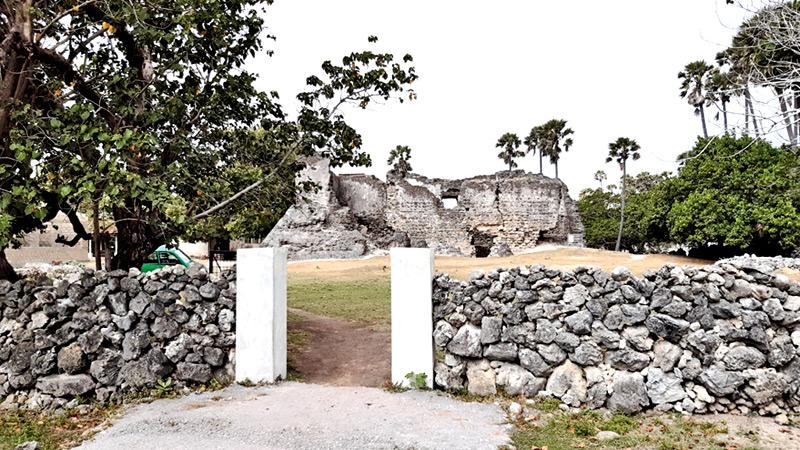
Delft is an isolated island, located approximately 30Kms off the west coast of the Jaffna peninsula. The Dutch named this island ‘Delft’ which was originally called Neduntheeve by the locals. The Portuguese called it Ilha das Vascas (the island of cows). Delft is an island with a rich history dating back to the period of the Chola dynasty, with the Portuguese, the Dutch and the British, being the first alien occupants in the bygone era. Colonial heritage can be witnessed everywhere on the island.
Among the other smaller islands around the northern sea, Delft is the largest with a habitable land area of 50Km, with a population of around 5,000 Tamils whose main livelihood is fishing. The island is only accessible by water or air and is 8 Kms in length and 6Kms in width.
The journey to Delft begins at the Kurikadduwan pier. When I reached the pier, already there were local and foreign tourists waiting to board the ferry bound for Delft. Most of them were Delft islanders while some were visitors. The ferry service is supervised by the Sri Lanka Navy, operating it at an affordable rate while a free ferry service is also operated by the Road Development Authority (RDA).
Most of the roads in the island are dusty and winding, and it is not wise to speed along the old macadamized roads as some of them are full of pot holes with metals and macadam strewn all over. Everywhere the walls and the fences are made of coral stones, which is a common sight.
The vegetation in the island is of a semi-arid tropical type with palmyrah palms, dry shrubs and grass. There are also other species such as margosa, gamsooriya, coconut – all native to tropical islands such as Sri Lanka. Scattered throughout the island are quaint villages. The villagers are mainly dairy farmers, with cattle, poultry and goats while some are engaged in agriculture. A few small boutiques sell various sundry items, especially palmyrah based products.
We first visited the eastern part of the island where we saw the dark coloured limestone, called ‘growing stone’ that claims to be growing with the passage of time. It is a natural phenomenon to see a rock growing in such a manner. A Hindu temple is located here, and the stone is venerated by the people.
The specialty of the massive baobab tree on the island is that it has a huge hollow in its trunk. The hollow is so large that around ten people could hide inside. I have seen a conserved baobab tree in Mannar which is also of the same size but without a hollow in the trunk. These baobab trees were brought to Ceylon by the seafaring Arab traders which are regarded as the longest-lived tree species on earth. They are native to Ethiopia and are found in Central Africa.
Travelling ahead, we could see one or two tanks filled with water. The water on the island is slightly brackish and not drinkable, but there are places where villagers can get clean water. The islanders mainly use water from dug wells.
Adjoining the newly built Delft Divisional Secretariat are remains of an old building said to be a hospital built by the Dutch, with a tall structure called pigeon cote. The pigeon cote was built by the Dutch to keep their messenger pigeons. When the British took over the island, the Dutch hospital was converted to a Magistrate’s Court.
The sandy beach on the island attracts many tourists. On the far side of the coast fishermen are seen engaging in fishing activities. After a short walk on the beach, we visited the island’s main landmark – the Dutch Fort, located in the central part of the Delft island. It was originally built by the Portuguese and later taken over by the Dutch and thereafter the British, who used it for their administrative purposes. This small fort of two floors with a dungeon is made of coral and limestone. It is now in ruins with the walls collapsed, but still fascinating.
The Dutch stable is yet another attraction here, built by them to keep their horses brought from foreign countries. In the stable is a large footprint imprinted on the wet cement mixture on the ground. It is called ‘Hanuman’s foot’ though actually there isn’t sufficient proof to substantiate this fact. All around the stable grounds are coral fenced enclosures and also the remains of an old building made of coral which is 150m long and 10m wide. What remains here are its massive pillars and the walls.
In the southeastern coast of the island, is a tower called ‘Quindah Tower’ or ‘Queen’s Tower’ built by the Dutch, who used it as a lighthouse to signal the ships sailing the seas.
In the open grassy plains, herds of feral ponies and horses are seen freely roaming and grazing. They are the descendants of their alien forbearers abandoned on the island. They are not lassoed, but some of them are privately owned.However, as a protective law has been placed over the horses, it is forbidden to remove them from the island.
Finally, on the way to visit the remains of a chaitya we came across the ruins of a tiny Hindu Kovil by the roadside. The Kovil is believed to have been built during the period of the Chola king. However, not much is known about these old structures. The Buddhist stupa has Brahmin inscriptions that date back to the 1st and 2nd centuries and Tamil inscriptions from the 15th or 16th centuries.
The Government has now provided Delft island all infrastructure facilities. Already a few state institutions have been established, including a police station, a hospital and seven schools. The island has been provided with modern telecommunication facilities as well. Of course, Delft is an island of peace and calm.
